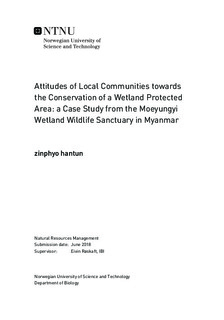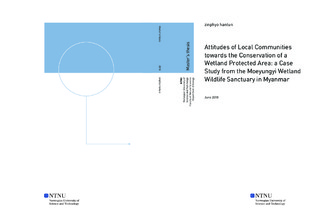| dc.description.abstract | Attitudinal studies are globally being recognized as useful indicators for evaluating the efficiency of conservation policy. An understanding of the attitudes of local communities towards nearby protected areas (PAs) helps to bridge the knowledge gap between public acceptance and conservation interventions. Many factors stimulate community attitudes to be positive or negative. This study aimed to explore linkages among conservation attitudes on PAs, interactions with PAs and how PAs are perceived. Based on geographic distance, 216 randomly selected households were interviewed from 12 villages around the Moeyungyi Wetland Wildlife Sanctuary in Myanmar. I assessed the general attitudes through a sampling population with 5 dependent variables: feelings towards PAs, relationship with PA management, trust in PA staff, perception that PAs are necessary for the long-term existence of biodiversity, and active participation in PA conservation. The most important variables that explained respondents attitudes regarded dependency on PA resources, perceived benefits of PAs, experience of losses (i.e., direct or opportunity costs), and village distance to the PA boundary. The results showed that individual perceptions were more dominant in shaping attitudes than were socio-demographic factors (gender, age, education, wealth). Despite the complex magnitude of the effects of resource dependency on attitudes, people with the least dependency had more positive attitudes. Overall, 78% of the respondents appreciated the wetland benefits of the PA landscape, but those who thought that they attain the benefits were more antagonistic. In general, those who faced conflicts with PA management, those who were dissatisfied with fence-and-fine conservation, and those living in the vicinity of PAs expressed more negative attitudes. The results indicate that negative attitudes will remain unchanged if the real costs of PAs are higher than their perceived benefits, which is an important factor to consider in PA conservation. | |

